Storing the ascii code of a character occupies one byte. ASCII code is a 7-bit encoding, but it must occupy a full byte, which is 8 bits, when stored. The highest bit is 0, and the remaining 7 bits represent the ASCII code.

#The ASCII code of one character occupies one byte of storage space.
(Video tutorial recommendation: java course)
ASCII code is a 7-bit encoding, but it must occupy 1 byte when stored, that is, it occupies 8 bits, the highest bit is 0, and the remaining 7 bits represent the ASCII code.
ASCII code uses a specified 7-bit or 8-bit binary number combination to represent 128 or 256 possible characters. Standard ASCII code, also called basic ASCII code, uses 7 binary digits (the remaining 1 binary digit is 0) to represent all uppercase and lowercase letters, numbers 0 to 9, punctuation marks, and special controls used in American English. character.
Among them: 0~31 and 127 (33 in total) are control characters or special communication characters (the rest are displayable characters), such as control characters: LF (line feed), CR (carriage return), FF ( Page feed), DEL (delete), BS (backspace), BEL (ring), etc.; communication special characters: SOH (head of text), EOT (end of text), ACK (confirmation), etc.; ASCII values are 8, 9 , 10 and 13 are converted to backspace, tab, line feed and carriage return characters respectively. They do not have a specific graphic display, but will have different effects on text display depending on the application.
32~126 (95 in total) are characters (32 is a space), of which 48~57 are ten Arabic numerals from 0 to 9.
65~90 are 26 uppercase English letters, 97~122 are 26 lowercase English letters, and the rest are some punctuation marks, arithmetic symbols, etc.
Also note that in standard ASCII, its highest bit (b7) is used as a parity bit. The so-called parity check refers to a method used to check whether errors occur during code transmission. It is generally divided into two types: odd check and even check. Odd parity rules: the number of 1's in a byte of the correct code must be an odd number. If it is not an odd number, add 1 to the highest bit b7; even parity rules: the number of 1's in a byte of the correct code must be an even number. , if it is not an even number, add 1 to the highest bit b7.
The last 128 are called extended ASCII codes. Many x86-based systems support the use of extended (or "high") ASCII. Extended ASCII allows the 8th bit of each character to be used to determine an additional 128 special symbol characters, foreign letters, and graphic symbols.
Recommended graphic tutorials: Getting started with java
The above is the detailed content of How many bytes does it take to store the ascii code of a character?. For more information, please follow other related articles on the PHP Chinese website!
 ASCII码对照表Jun 21, 2023 pm 05:36 PM
ASCII码对照表Jun 21, 2023 pm 05:36 PMASCII(American Standard Code for Information Interchange,美国信息互换标准代码)是一套基于拉丁字母的字符编码,共收录了 128 个字符,用一个字节就可以存储,它等同于国际标准 ISO/IEC 646。ASCII 规范于 1967 年第一次发布,最后一次更新是在 1986 年。
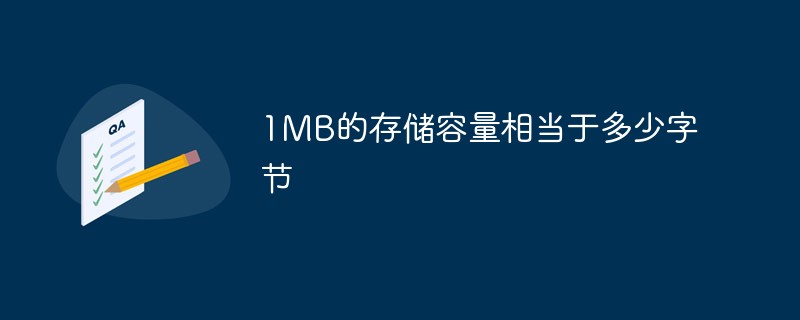 1MB的存储容量相当于多少字节Mar 03, 2023 pm 05:42 PM
1MB的存储容量相当于多少字节Mar 03, 2023 pm 05:42 PM1MB的存储容量相当于2的20次方个字节,即1048576个字节。MB是计算机中的一种储存单位,读作“兆”;因为1MB等于1024KB,而1KB等于1024B(字节),因此1MB等于1048576(1024 *1024)个字节。
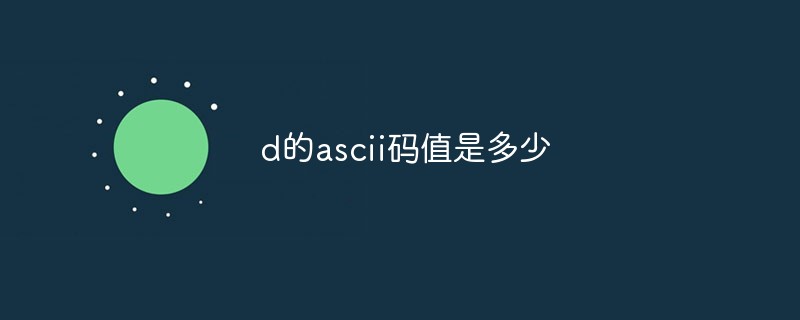 d的ascii码值是多少Feb 02, 2023 am 11:26 AM
d的ascii码值是多少Feb 02, 2023 am 11:26 AMd的ascii码值是100;因为a的ASCII代码值是十六进制数61H,即十进制值是97,而d在a后三位,则d的ASCII代码值是“97+3=100”;ASCII码使用指定的7位或8位二进制数组合来表示128或256种可能的字符。
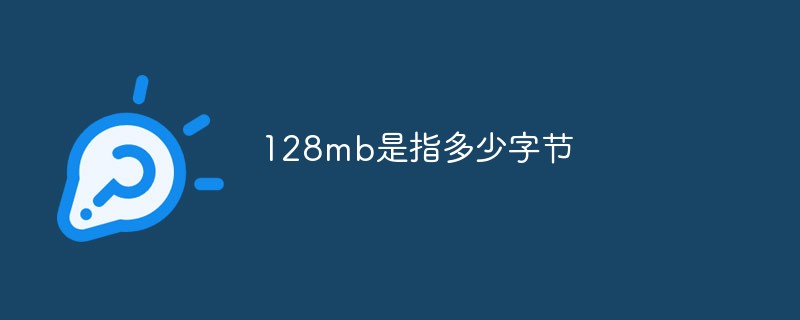 128mb是指多少字节Nov 29, 2022 am 10:35 AM
128mb是指多少字节Nov 29, 2022 am 10:35 AM128mb是指134217728字节;字节换算公式是“1MB=1024KB=1048576B=8388608bit”,其表示可以保存1048576个英文字母、524288个汉字;流量单位换算公式是1GB=1024MB,1MB=1024KB,1KB=1024B。
 1bit等于多少字节Mar 09, 2023 pm 03:11 PM
1bit等于多少字节Mar 09, 2023 pm 03:11 PM1bit等于八分之一个字节。二进制数系统中,每个0或1就是一个位(bit),位是数据存储的最小单位;每8个位(bit,简写为b)组成一个字节(Byte),因此“1字节(Byte)=8位(bit)”。在多数的计算机系统中,一个字节是一个8位(bit)长的数据单位,大多数的计算机用一个字节表示一个字符、数字或其他字符。
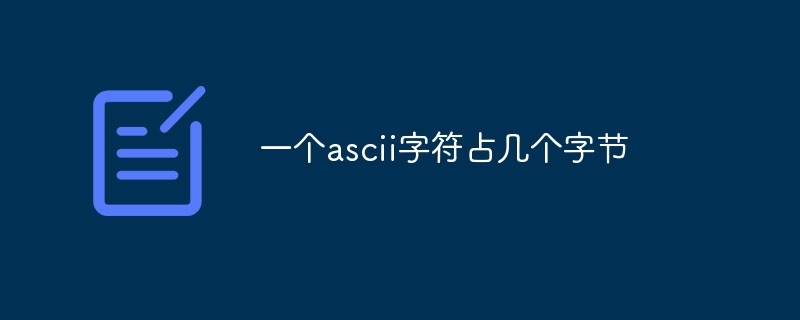 一个ascii字符占几个字节Mar 09, 2023 pm 03:49 PM
一个ascii字符占几个字节Mar 09, 2023 pm 03:49 PM一个ascii字符占1个字节。ASCII码字符在计算机中采用7位或8位二进制编码表示,并保存在一个字节中,即一个ASCII码占用一个字节。ASCII码可分为标准ASCII码和扩展ASCII码,其中标准ASCII码也叫基础ASCII码,使用7位二进制数(剩下的1位二进制为0)来表示所有的大写和小写字母,数字0到9、标点符号,以及在美式英语中使用的特殊控制字符。
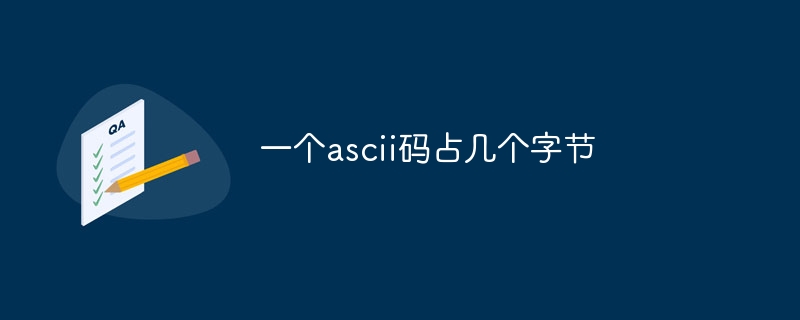 一个ascii码占几个字节Sep 07, 2023 pm 04:03 PM
一个ascii码占几个字节Sep 07, 2023 pm 04:03 PM一个ascii码占一个字节,ascii码是一种用于表示字符的编码标准,它使用7位二进制数来表示128个不同的字符,包括字母、数字、标点符号和特殊字符等。一个字节是计算机存储单位的基本单元,它由8个二进制位组成,每个二进制位可以是0或1,一个字节可以表示256个不同的数值,因此可以表示ascii码中的所有字符。
 utf8编码汉字占多少字节Feb 21, 2023 am 11:40 AM
utf8编码汉字占多少字节Feb 21, 2023 am 11:40 AMutf8编码汉字占3个字节。在UTF-8编码中,一个中文等于三个字节,一个中文标点占三个字节;而在Unicode编码中,一个中文(含繁体)等于两个字节。UTF-8使用1~4字节为每个字符编码,一个US-ASCIl字符只需1字节编码,带有变音符号的拉丁文、希腊文、西里尔字母、亚美尼亚语、希伯来文、阿拉伯文、叙利亚文等字母则需要2字节编码。

Hot AI Tools

Undresser.AI Undress
AI-powered app for creating realistic nude photos

AI Clothes Remover
Online AI tool for removing clothes from photos.

Undress AI Tool
Undress images for free

Clothoff.io
AI clothes remover

AI Hentai Generator
Generate AI Hentai for free.

Hot Article

Hot Tools

SAP NetWeaver Server Adapter for Eclipse
Integrate Eclipse with SAP NetWeaver application server.

EditPlus Chinese cracked version
Small size, syntax highlighting, does not support code prompt function

Dreamweaver Mac version
Visual web development tools

Notepad++7.3.1
Easy-to-use and free code editor

VSCode Windows 64-bit Download
A free and powerful IDE editor launched by Microsoft






